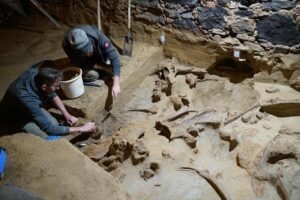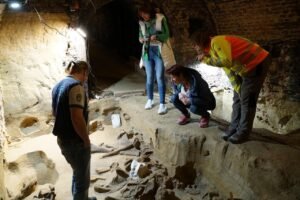In Austria, a local winegrower uncovered a trove of mammoth bones estimated to be between 30,000 and 40,000 years old.
 Thomas Einwögerer and Hannah Parow-Souchon preparing the bones for recovery Credit: OeAW-OeAI/Yannik Merkl
Thomas Einwögerer and Hannah Parow-Souchon preparing the bones for recovery Credit: OeAW-OeAI/Yannik Merkl
Andreas Pernerstorfer, while refurbishing his wine cellar in Gobelsburg, Lower Austria, stumbled upon what he initially thought was a piece of wood, reminiscent of a tale his grandfather once shared about finding teeth in the cellar decades ago. However, this turned out to be far more significant as Pernerstorfer uncovered mammoth remains, marking one of the most significant archaeological finds in Austria in over a century.
The discovery, described as an “archaeological sensation” by researchers from the Austrian Archaeological Insтιтute of the Austrian Academy of Sciences (OeAW), has unveiled several layers of mammoth bones, suggesting the presence of at least three individual mammoths.
Hannah Parow-Souchon, the lead archaeologist overseeing the excavation, said, “It’s the first time we’ve been able to investigate something like this in Austria using modern methods.” The bones, stacked atop each other, raise intriguing questions about how Stone Age humans interacted with and potentially hunted these enormous creatures.
 An archaeologist beside the mammoth bones discovered in Austria. Credit: OeAW-OeAI/H. Parow-Souchon
An archaeologist beside the mammoth bones discovered in Austria. Credit: OeAW-OeAI/H. Parow-Souchon
“We know that humans hunted mammoths, but we still know very little about how they did it,” remarked Parow-Souchon. The proximity of the mammoth bones to stone artifacts suggests the possibility that early humans may have set traps or utilized the natural landscape to capture these mammoths.
Mammoths, ancestors of modern elephants, roamed the Earth during the Pleistocene and early Holocene epochs. They evolved to inhabit various regions across the globe, from Africa to Europe, Asia, and even North America.
 Credit: OeAW-OeAI/Hannah Parow-Souchon
Credit: OeAW-OeAI/Hannah Parow-Souchon Credit: OeAW-OeAI/Thomas Einwögerer
Credit: OeAW-OeAI/Thomas Einwögerer
The mammoth bones excavated from Pernerstorfer’s cellar will undergo further examination before being transferred to the Natural History Museum Vienna for restoration.
The find in Gobelsburg echoes a similar discovery made 150 years ago in the same area, emphasizing the historical significance of the region for paleontological research.





